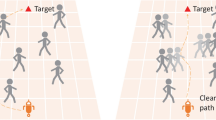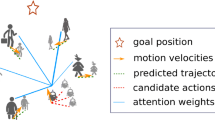Abstract
Navigating in crowd environments is challenging for mobile robots because not only the safety but also the comfort of surrounding pedestrians must be considered. In this work, a deep reinforcement learning framework is introduced for safe and socially compliant robot navigation. We propose a value network for robot decision-making that leverages spatial-temporal reasoning to comprehend crowd interactions. Based on the real-time speed of pedestrians, the hazardous areas that the robot needs to avoid are designed, and a reward function is formulated to guarantee the safety and comfort of pedestrians. Extensive simulation experiments validate that the developed framework outperforms the state-of-the-art methods in terms of success rate (up to 34% increase) and discomfort frequency (up to 54.72% decrease). In addition, real-world experiments illustrate that our approach can predict pedestrian dynamics and navigate the robot safely and reliably in crowds.










Similar content being viewed by others
References
Kruse T, Pandey AK, Alami R, Kirsch A (2013) Human-aware robot navigation: a survey. Robot Auton Syst 61(12):1726–1743
Hu Z, Zhao Y, Zhang S, Zhou L, Liu J (2022) Crowd-comfort robot navigation among dynamic environment based on social-stressed deep reinforcement learning. Int J Soc Robot 14(4):913–929
Sathyamoorthy AJ, Patel U, Paul M, Kumar NKS, Savle Y, Manocha D (2022) CoMet: Modeling group cohesion for socially compliant robot navigation in crowded scenes. IEEE Robot Autom Lett 7(2):1008–1015
Wang C, Chen X, Li C, Song R, Li Y, Meng MQ-H (2023) Chase and track: Toward safe and smooth trajectory planning for robotic navigation in dynamic environments. IEEE Trans Ind Electron 70(1):604–613
Helbing D, Molnr P (1995) Social force model for pedestrian dynamics. Phys Rev E 51(5):4282–4286
Van Den Berg J, Lin M, Manocha D (2008) Reciprocal velocity obstacles for real-time multi-agent navigation. In: 2008 IEEE International Conference on Robotics and Automation. IEEE, pp. 1928–1935
Van Den Berg J, Guy SJ, Lin M, Manocha D (2011) Reciprocal n-body collision avoidance. Robotics Research. Springer, Berlin, pp 3–19
Trautman P, Krause A (2010) Unfreezing the robot: Navigation in dense, interacting crowds. In: 2010 IEEE/RSJ International Conference on Intelligent Robots and Systems. IEEE, pp. 797–803
Sathyamoorthy AJ, Patel U, Guan T, Manocha D (2020) Frozone: freezing-free, pedestrian-friendly navigation in human crowds. IEEE Robot Autom Lett 5(3):4352–4359
Kretzschmar H, Kuderer M, Burgard W (2014) Learning to predict trajectories of cooperatively navigating agents. In: 2014 IEEE International Conference on Robotics and Automation. IEEE, pp. 4015–4020
Pfeiffer M, Schwesinger U, Sommer H, Galceran E, Siegwart R (2016) Predicting actions to act predictably: Cooperative partial motion planning with maximum entropy models. In: 2016 IEEE/RSJ International Conference on Intelligent Robots and Systems. IEEE, pp. 2096–2101
Kretzschmar H, Spies M, Sprunk C, Burgard W (2016) Socially compliant mobile robot navigation via inverse reinforcement learning. Int J Robot Res 35(11):1289–1307
Che Y, Okamura AM, Sadigh D (2020) Efficient and trustworthy social navigation via explicit and implicit robot-human communication. IEEE Trans Robot 36(3):692–707
Tai L, Zhang J, Liu M, Burgard W (2018) Socially compliant navigation through raw depth inputs with generative adversarial imitation learning. In: 2018 IEEE International Conference on Robotics and Automation. IEEE, pp. 1111–1117
Long P, Liu W, Pan J (2017) Deep-learned collision avoidance policy for distributed multiagent navigation. IEEE Robot Autom Lett 2(2):656–663
Liu Y, Xu A, Chen Z (2018) Map-based deep imitation learning for obstacle avoidance. In: 2018 IEEE/RSJ International Conference on Intelligent Robots and Systems. IEEE, pp. 8644–8649
Chen YF, Everett M, Liu M, How JP (2017) Socially aware motion planning with deep reinforcement learning. In: 2017 IEEE/RSJ International Conference on Intelligent Robots and Systems. IEEE, pp. 1343–1350
Cui Y, Zhang H, Wang Y, Xiong R (2021) Learning world transition model for socially aware robot navigation. In: 2021 IEEE International Conference on Robotics and Automation. IEEE, pp. 9262–9268
Chen YF, Liu M, Everett M, How JP (2017) Decentralized non-communicating multiagent collision avoidance with deep reinforcement learning. In: 2017 IEEE International Conference on Robotics and Automation. IEEE, pp. 285–292
Everett M, Chen YF, How JP (2018) Motion planning among dynamic, decision-making agents with deep reinforcement learning. In: 2018 IEEE/RSJ International Conference on Intelligent Robots and Systems. IEEE, pp. 3052–3059
Chen C, Liu Y, Kreiss S, Alahi A (2019) Crowd-robot interaction: Crowd-aware robot navigation with attention-based deep reinforcement learning. In: 2019 IEEE International Conference on Robotics and Automation. IEEE, pp. 6015–6022
Bohannon RW (1997) Comfortable and maximum walking speed of adults aged 20–79 years: reference values and determinants. Age Age 26(1):15–19
Samsani SS, Muhammad MS (2021) Socially compliant robot navigation in crowded environment by human behavior resemblance using deep reinforcement learning. IEEE Robot Autom Lett 6(3):5223–5230
Hall ET (1966) The hidden dimension. Anchor, Garden City, NY
Sutton RS, Barto AG (1998) Reinforcement learning: An introduction. MIT Press, Cambridge, MA
Funding
This work was supported in part by the National Key R & D Program of China under Grant 2017YFB1302400, the Jinan “20 New Colleges and Universities” Funded Scientific Research Leader Studio under Grant 2021GXRC079, the Major Agricultural Applied Technological Innovation Projects of Shandong Province under Grant SD2019NJ014, the Shandong Natural Science Foundation under Grant ZR2019MF064, and the Beijing Advanced Innovation Center for Intelligent Robots and Systems under Grant 2019IRS19.
Author information
Authors and Affiliations
Corresponding author
Ethics declarations
Conflict of interest
The authors declare that they have no conflict of interest.
Additional information
Publisher's Note
Springer Nature remains neutral with regard to jurisdictional claims in published maps and institutional affiliations.
Rights and permissions
Springer Nature or its licensor (e.g. a society or other partner) holds exclusive rights to this article under a publishing agreement with the author(s) or other rightsholder(s); author self-archiving of the accepted manuscript version of this article is solely governed by the terms of such publishing agreement and applicable law.
About this article
Cite this article
Xue, B., Gao, M., Wang, C. et al. Crowd-Aware Socially Compliant Robot Navigation via Deep Reinforcement Learning. Int J of Soc Robotics 16, 197–209 (2024). https://doi.org/10.1007/s12369-023-01071-4
Accepted:
Published:
Issue Date:
DOI: https://doi.org/10.1007/s12369-023-01071-4




